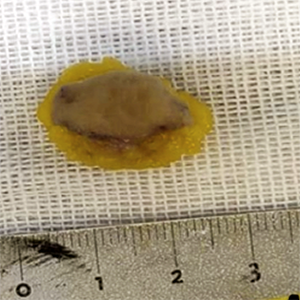A case of human Dirofilaria repens in Rome, Italy: a clinical and radiological challenge

HTML: 7
All claims expressed in this article are solely those of the authors and do not necessarily represent those of their affiliated organizations, or those of the publisher, the editors and the reviewers. Any product that may be evaluated in this article or claim that may be made by its manufacturer is not guaranteed or endorsed by the publisher.
Human subcutaneous dirofilariasis caused by Dirofilaria repens is a vector-borne zoonotic disease mostly transmitted from dogs to humans through a mosquito’s blood meal. Heartworms replication is amplified by the climate change, the increase of the range of suitable vectors, the facilitation of pet travel and the high rate of undiagnosed dirofilariasis in dogs. We describe a case of a young Romanian woman, resident in Rome for 18 years, that came to our attention for the appearance for five months of a subcutaneous nodule in the left arm. The patient reported that she first felt an insect bite, after which she noticed the onset of an erythematous and itchy wheal in the same skin area, turned into a subcutaneous nodule within a few weeks. The ultrasound examination showed a hypoechoic subcutaneous formation of 1,2 cm in diameter, containing a ribbon-like structure made up of hyperechoic parallel double lines, reminiscent of a warm. Based on this suspicion, we opted for the surgical radicalization of the lesion. The histological examination confirmed the radiological hypothesis of a warm-like foreign body morphologically compatible with Dirofilaria repens. Our experience shows how a clinical nonspecific skin nodular lesion may conceal an unexpected and unsettling diagnosis of subcutaneous Dirofilaria repens.
Pampiglione S, Rivasi F. Human dirofilariasis due to Dirofilaria (Nochtiella) repens: an update of world literature from 1995 to 2000. Parassitologia 2000;42:231-54.
Ercolani G. Helmintological observations on the dimorbiosis of nematodes: on the Filaria immitis and on a new species of dog’s distoma. Mem R Acad Sci Ist Bol 1874;3:390-441 [in Italian].
Otranto D, Dantas-Torres F, Brianti E, et al. Vector-borne helminths of dogs and humans in Europe. Parasit Vectors 2013;6:16. DOI: https://doi.org/10.1186/1756-3305-6-16
Genchi C, Kramer L. Subcutaneous dirofilariosis (Dirofilaria repens): an infection spreading throughout the old world. Parasit Vectors 2017;10:517. DOI: https://doi.org/10.1186/s13071-017-2434-8
Capelli G, Genchi C, Baneth G, et al. Recent advances on Dirofilaria repens in dogs and humans in Europe. Parasit Vectors 2018;11:663. DOI: https://doi.org/10.1186/s13071-018-3205-x
Sałamatin RV, Pavlikovska TM, Sagach OS, et al. Human dirofilariasis due to Dirofilaria repens in Ukraine, an emergent zoonosis: epidemiological report of 1465 cases. Acta Parasitol 2013;58:592–8. DOI: https://doi.org/10.2478/s11686-013-0187-x
Pampiglione S, Canestri Trotti G, Rivasi F. Human dirofilariasis due to Dirofilaria (Nochtiella) repens: a review of world literature. Parassitologia 1995;37:149–93.
Kartashev V, Tverdokhlebova T, Korzan A, et al. Human subcutaneous/ocular dirofilariasis in the Russian Federation and Belarus, 1997–2013. Int J Infect Dis 2015;33:209–11. DOI: https://doi.org/10.1016/j.ijid.2015.02.017
Scaramozzino P, Gabrielli S, Di Paolo M, et al. Dog filariosis in the Lazio region (Central Italy): first report on the presence of Dirofilaria repens. BMC Infect Dis 2005;5:75. DOI: https://doi.org/10.1186/1471-2334-5-75
Magi M, Guardone L, Mignone W, et al. Canine filarial infections in Liguria, north-west Italy. J Helminthol 2016;90:121–4. DOI: https://doi.org/10.1017/S0022149X15000012
Giangaspero A, Marangi M, Latrofa MS, et al. Evidences of increasing risk of dirofilarioses in southern Italy. Parasitol Res 2013;112:1357–61. DOI: https://doi.org/10.1007/s00436-012-3206-1
Pampiglione S, Rivasi F, Angeli G, et al. Dirofilariasis due to Dirofilaria repens in Italy, an emergent zoonosis: report of 60 new cases. Histopathology 2001;38:344-54. DOI: https://doi.org/10.1046/j.1365-2559.2001.01099.x
KKW T, Wong SSY, Poon RWS, et al. A novel Dirofilaria species causing human and canine infections in Hong Kong. J Clin Microbiol 2012;50:3534–41. DOI: https://doi.org/10.1128/JCM.01590-12
Yilmaz E, Fritzenwanker M, Pantchev N, et al. The mitochondrial genomes of the zoonotic canine filarial parasites Dirofilaria (Nochtiella) repens and Candidatus Dirofilaria (Nochtiella) honkongensis provide evidence for presence of cryptic species. PLoS Negl Trop Dis 2016;10:e0005028. DOI: https://doi.org/10.1371/journal.pntd.0005028
Mirahmadi H, Maleki A, Hasanzadeh R, et al. Ocular dirofilariasis by Dirofilaria immitis in a child in Iran: a case report and review of the literature. Parasitol Int 2017;66:978–81. DOI: https://doi.org/10.1016/j.parint.2016.10.022
Ermakova LA, Nagorny SA, Krivorotova EY, et al. Dirofilaria repens in the Russian Federation: current epidemiology, diagnosis, and treatment from a federal reference center perspective. Int J Infect Dis 2014;23:47–52. DOI: https://doi.org/10.1016/j.ijid.2014.02.008
Genchi C, Kramer LH. The prevalence of Dirofilaria immitis and D. repens in the Old World. Vet Parasitol 2020;280:108995. DOI: https://doi.org/10.1016/j.vetpar.2019.108995
Copyright (c) 2022 the Author(s)

This work is licensed under a Creative Commons Attribution-NonCommercial 4.0 International License.
PAGEPress has chosen to apply the Creative Commons Attribution NonCommercial 4.0 International License (CC BY-NC 4.0) to all manuscripts to be published.





 https://doi.org/10.4081/dr.2022.9354
https://doi.org/10.4081/dr.2022.9354



